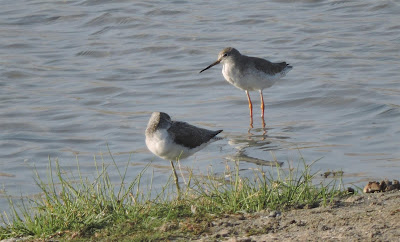In passing Jens mentioned he had seen and photographed a lesser flamingo at Khawr Rori the day before.
I knew it was a vagrant. Indeed there have only been five previous records. However one was of a flock of 270! birds back in 1995.
I took my first chance to go to Khawr Rori and I was there at 3.30 pm the next day. I didn't want to miss my chance.
What I saw surprised me in a very pleasant way.
four lesser flamingo
Jens had seen his bird near the dhows exhibit. I scanned the banks close-by and found not one but four. They appeared to be ravenously hungry and would almost certainly have allowed much closer approach than I risked.
two lesser flamingo
They were not venturing into the water but seemed happy to eat at the edge. I watched in awe for 10 minutes or so.
pintail resting
wigeon (back) with garganey
Diving ducks are much rarer so far this winter than last. However other than shoveller and pintail, there were several teal and at least one each of garganey and wigeon. Although garganey is the first duck to arrive in Dhofar in the autumn, its numbers drop (but not to zero) in mid-winter.
three more lesser flamingo
While still scanning for ducks, this time on a far bank I realised that among the resting shoveller and pintail were three more lesser flamingo making seven in total.
male and female teal
Most male teal now have their breeding plumage.
Eurasian coot
In another part of the khawr on the north western spur, several coot were swimming. They were divided into two distinct groups. Looking closely I noticed that the larger group contained Eurasian coot. However the smaller group were all red-knobbed coot.
Red-knobbed coot
The adult red-knobbed coot are supposed to lose the knobs outside the breeding season, yet I have yet to see a time when they are missing. They also have bluish bills rather than pinkish ones of Eurasian coot. The feathers which intrude on the bill are rounded compared with the sharp intrusion on Eurasian coot. The red-knobbed coot are also less shy at Khawr Rawri.
greenshank and redshank
A hard look at the waders around the khawr did not reveal any rarities. Black-tailed godwit were the most numerous by far followed by Dunlin, curlew sandpiper, greenshank and redshank.
Since the sun was starting to fade, I decided to leave the main section of the khawr and head towards the north western reeds approached from the main road. I wanted to try to find crakes again.
One interesting bird seemed to be a possible marsh warbler. It's habits, plumage and structure seem closer to that species than reed warbler.
Most marsh warbler stop-over for a couple of months in east Africa before heading further south during December and January. If this is indeed a marsh warbler then it would be expected to move on too. In correspondence with Jens Eriksen he said it could be overlooked here.
potential marsh warbler
Two clamorous reed warbler were also seen and several more heard.
potential marsh warbler 2
Once again I had little difficulty in seeing crakes. There were at least two spotted crake and one Baillon's crake. Little crake is still alluding me.
spotted crake
The session was very productive. I saw 53 species in total in less than two and a half hours. Lesser flamingo also became species 319 on my Oman list.




















































